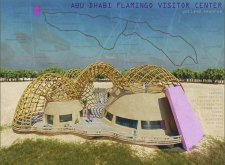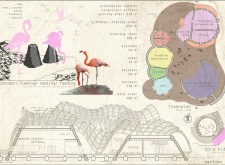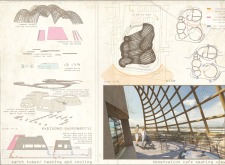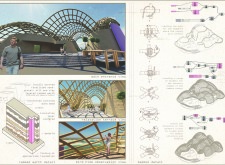5 key facts about this project
The design of the visitor center embodies the concepts of flow and harmony with its surroundings. The structure adopts organic forms that mimic the meandering patterns of the wetlands, effectively blending into the landscape. This design philosophy supports the overall mission of the center, which is to create a space where visitors can connect with the natural world. The roof structure, constructed from bamboo, features an undulating canopy that not only provides shade but also contributes to the thermal efficiency of the building. This natural material emphasizes sustainable practices and the use of locally sourced resources, aligning with the ecological mission of the project.
Functionally, the visitor center caters to a variety of needs, making it a multifaceted facility. It includes an information center that provides educational resources about the region's biodiversity, a café that allows visitors to rest and reflect, and observation areas specifically designed for birdwatching. These features enable the center to serve as a base for both casual visitors and serious nature enthusiasts, enhancing the overall visitor experience. The layout of the building facilitates easy navigation, with defined zones that support different activities while encouraging interaction with the environment.
Unique design approaches in this project are evident not only in its form but also in the thoughtful integration of sustainable technologies. The visitor center employs earth tubes for passive heating and cooling, which reduces reliance on mechanical systems and contributes to energy efficiency. The use of rammed earth for the walls provides effective insulation while showcasing local materials in a manner that respects the environment. Additionally, the careful selection of materials, such as wood for flooring and outdoor terraces, enhances the tactile experience of the center and contributes to its overall warmth and welcoming atmosphere.
Another key element of the Abu Dhabi Flamingo Visitor Center is its commitment to accessibility. The design includes features such as ramps and designated observation platforms that ensure visitors of all abilities can enjoy the experience without barriers. This inclusive approach reflects a broader understanding of the importance of making nature and education available to everyone.
As an architectural project, the Abu Dhabi Flamingo Visitor Center stands out for its respect for context, thoughtful material selection, and integration of sustainable practices. It serves not only as a functional space for education and observation but also as a symbol of conservation efforts within the region. The center encourages visitors to engage deeply with their surroundings, enhancing their appreciation for the local ecosystem and the biodiversity it contains.
To gain further insights into this project, exploring the architectural plans, sections, and overall design ideas provides a richer understanding of how architecture can harmoniously coexist with nature. Delving into these elements reveals the intricacies of the design process and the care taken to address both function and environment, highlighting a well-rounded approach to modern architectural challenges.


























